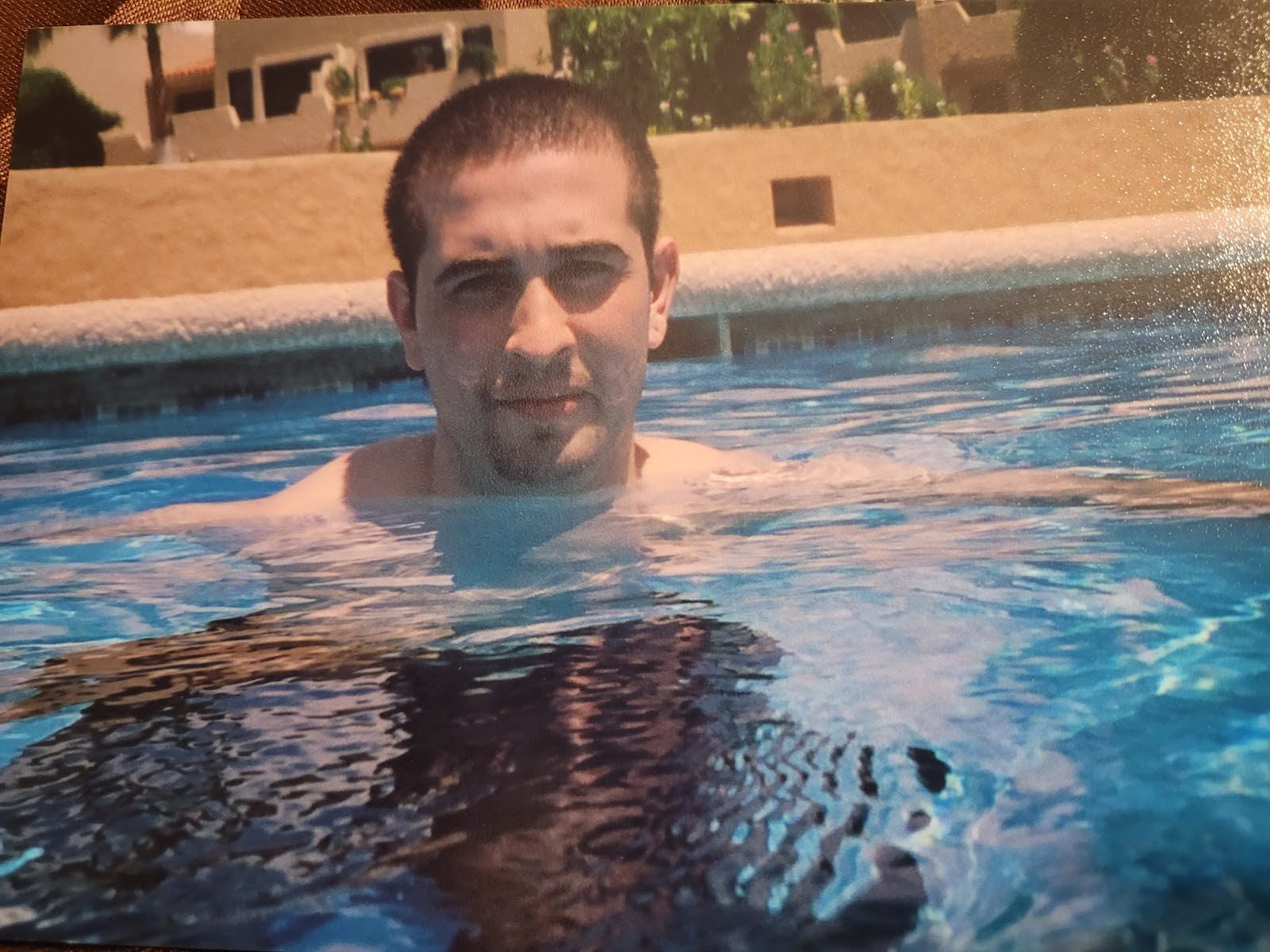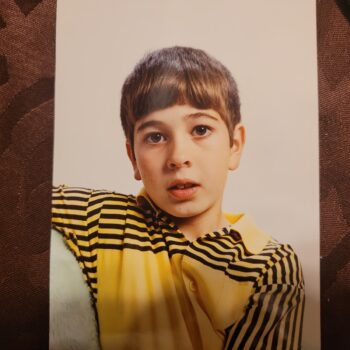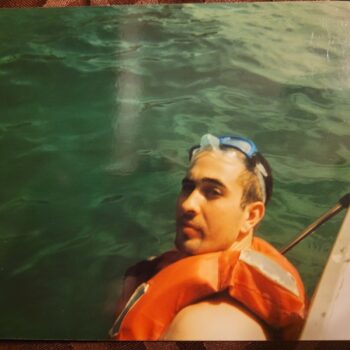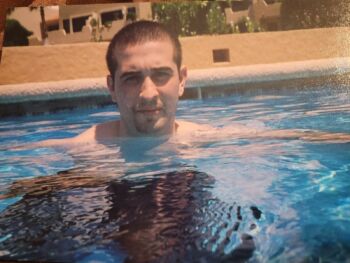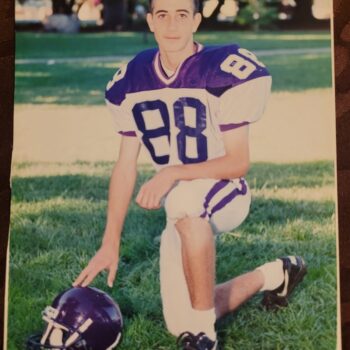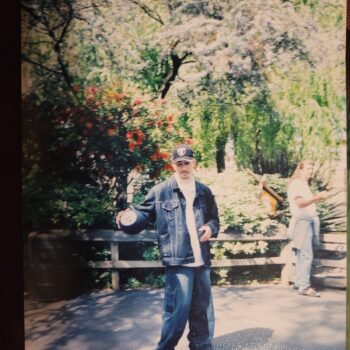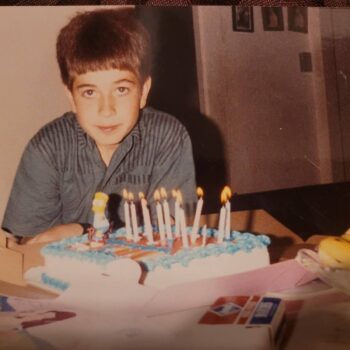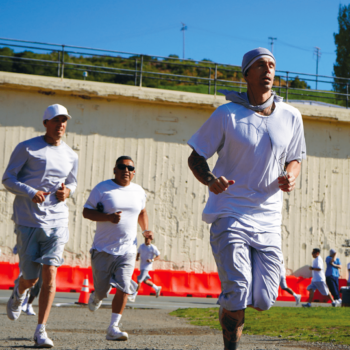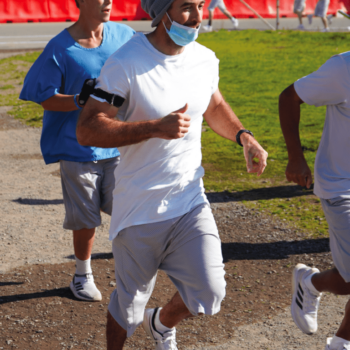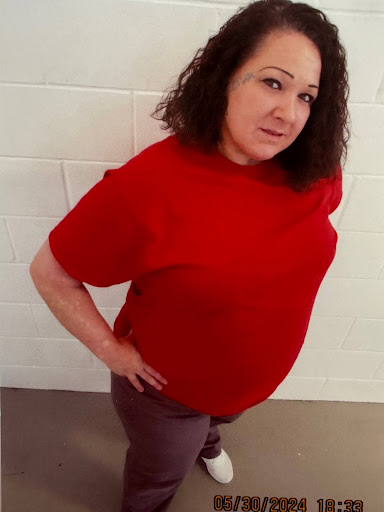Diane: It was great talking to you inside San Quentin. You were telling me you were really inspired by the “26.2 to life” movie that you saw. Tell me a little bit about that.
Jose: We watched it earlier this year, and I have just been here in San Quentin for two years because I was in High Desert first, so I got here in April of 2022. I started running in High Desert. And then, when I got here, I got into the “1000 Mile Club.” I started to see what it was about and then watched the movie. It inspired me not only to finish the marathon but to see if I could get the record and finish it in under three hours. I had never run a marathon before, so that was the motivation, my inspiration. I was like, “If I am gonna run this, I’m going to see if I can beat the time and get it under three hours.” That was my first goal.
Diane: How much had you been running prior to coming to San Quentin?
Jose: Probably like five years.
Diane: How far?
Jose: At High Desert, I just ran 25 laps. That was my constant run. When I came out to San Quentin, I was like, Okay, let me do 25 laps because over there, they don’t have the running program they have here, So I was on my own. Then I got here, and it was a whole new world. Here, the 1000 Mile Club gets you prepared to run the marathon. It starts at three miles, six miles, and then it starts building up every month. I started conditioning myself to run the 26.2 miles.
Diane: How many laps is it inside for the entire marathon?
Jose: 105.
Diane: How long have you been training for the marathon?
Jose: A year and a half.
Diane: What does a training schedule look like inside prison?
Jose: I ran three or four days a week before my job. The yard would open from eight to three, so I would come out at eight. I run about an hour and a half, and at one in the afternoon, I run again for another hour and a half, and I will count in my laps. I have a Monday to Friday-job now, so my running is shortening up to running in the mornings and the weekends.
Diane: When did you start enjoying running?
Jose: Six years ago. When I started, I ran two to five laps and started building up. I feel like it’s a purpose you have. If I run, I feel like I have done something. I feel good about myself.
Diane: Did you run prior to coming to prison?
Jose: No, I have never ran before. I used to play high school football, but I never ran.
Diane: What made you first start running in prison?
Jose: In the prison yard, we did pull-ups, push-ups, and running. My first thought was to let me run to warm up and get my body moving. Then, I do some push-ups and pull-ups. That was like my warm-up, you know.
Diane: How was training for the marathon?
Jose: Last February, we had the three-mile run, which is 12 laps. Then, in March, we had the six-mile, 24 laps. It took one hour, and then we built up to ten miles. It kept building. In September, we started running for two hours straight to see how many laps we could do in two hours. We saw how many laps we could do in October in three hours. And that right there is a benchmark. We could do three hours; we are getting closer to the marathon laps.
Diane: What did you do to improve your time?
Jose: My legs were wearing out at the end of my last three-hour race. I knew I had to focus on that and the marathon, which would help at the three-hour mark. I needed to do some more legwork. And that’s when I started working out during the week with squats.
Diane: Take us through the day of the marathon.
Jose: The day before, I told my boss I was running a marathon on Friday. Was it okay if I didn’t come to work? I usually come to work at five in the morning, and I want to save my energy. He has always been okay with it. They told me to take the day off.
Diane: How did you feel the morning of the race?
Jose: I was nervous. It was the coach’s last marathon ever. So we were going to walk a lap with the coach, Frank. I was standing right next to him, so I decided to talk to him and get his advice or any tips before the start of the race. I felt a little under pressure. Throughout the month, they said, “You got this, you got the record, you can beat the record.” I could do it, but a lot could happen during the race. So I felt that pressure, but I was like- I ran for fun. I run because I enjoy doing it. I am going out there to finish the marathon. That was my whole thing: trying to get the record and finish the marathon because I had never completed one. I wanted to enjoy myself and see what happens. So, the race starts, and I feel good. The first hour started, and after an hour and a half, two hours, I still felt good. I had another guy, another member; he was encouraging me, like throughout the laps, he was encouraging me, “Hey, you got this, you got this.” He counted my laps, encouraged me throughout, and let me know where I was and how many miles I had. And giving me encouragement: “Keep this pace,” “You got it,” “You could finish it at this time.” It assured me where to continue my pace; I told myself I would not slow down. It was two to two and a half hours, and I was like- I could do this. My only worries were my legs giving out or a cramp. Maybe I feel a cramp growing, and I must stop running and relax. My pace was six minutes a mile at the beginning of the race, and then I started slowing down to seven minutes a mile or more. I ended up finishing in three hours and five minutes. That was my finishing time.
Diane: I was speaking with Markelle, the previous title holder. He was saying you were lucky that there weren’t any alarms; he had one that was damaging to him initially. For people who don’t know that might be listening, once a prison alarm goes off, everybody in the yard has to hit the ground regardless of whether you are running a marathon or not. Did you have any alarms go off?
Jose: I don’t think there were any alarms, and that was another benefit that helped. If there was an alarm, once you start running and have an hour in or an hour and a half in and stop and sit down, you need to get your body to start running again, and it feels hard. Sometimes, you might want to rest in the beginning or the middle, but it’s worse sitting down and then trying to get back started. I tried to keep my pace. I was slowing down, but I wasn’t slowing down to a pace where I wouldn’t get at least a mark, you know? It was a benefit and helpful that there were no alarms.
Diane: How did you feel after the race?
Jose: I was hurting. I couldn’t walk, I couldn’t sit down. My calves were burning. I tried to walk a lap, but I couldn’t do anything. I was like, “This is so painful,” finally, I ate some granola bars, which I ate throughout the race, too; it was helpful. Some people hand out water or have energy bars; they help out because water intake is important for cramping, too. At the forty-five mark, I started drinking water, and then forty-five minutes and, like an hour and a half, I started drinking more water. And by the two-hour mark, I was drinking more water. I finished three water bottles throughout the race. I can’t stop and drink; as I am running, I drink the water. It is kind of a part of the running, too.
Diane: Have you had any role models in your running career, and if not, do you have any role models in life?
Jose: Mostly the members of the 1,000 Mile Running Club. People like Markelle are role models. He won most of the records in the 1,000 Mile Club. That’s a benchmark. I am working to see if I could match that. Even the 1,000 Mile Club members try to encourage each other. When we see each other out there, we greet them, ask how they are doing, and talk to them about running and life. We know how each other is doing in their life and if something else is going on. But encourage and help, too. It helps me motivate myself to be part of a team.
Diane: It’s lovely you have support from volunteers who walk into San Quentin weekly. Is there anything else that you want to share?
Jose: There’s something special San Quentin has. So much help comes from an outsider coming in, having fun, and volunteering their time. Like yourself, you go in and volunteer and help out. There is something to look forward to. They come out to help me or help us. I should do my part, too. It’s not just that they come and support me; I have to do my part, too.
When I run, I don’t count my laps. I just enjoy it. I put my earpods in and listen to some music, I forget that I am in here. I put myself in a moment where I am not in prison, a moment where I am enjoying my running and I get to be healthy and positive and have something to look forward to.
Diane: I know you touched upon this earlier, but can you articulate the positive changes in your mental well-being after you started running?
Jose: It gave me a purpose. Every morning when I get up, it’s like, today I will go out there and be active. It’s nice and sunny going outside, and I get some laps in. When I run, I don’t count my laps. I enjoy it. I put my earphones in and listen to some music; I forget that I am in here. I put myself in a moment where I am not in prison; I am enjoying my running, and I get to be healthy and positive and have something to look forward to.
Diane: Are there any specific challenges that you faced?
Jose: There is an uphill part of the course. The whole track is not even throughout. If it rained the night before, you might run into some puddles or rocks. The birds are around, and you don’t want to step on them. Throughout the track, there are a few challenges to go through.
Diane: The biggest challenge I notice being a free person is that the track isn’t marked off. A lot of people are doing a ton of other things at the same time. So they might be playing basketball, taking a class, hanging out, heading to class or their cell, talking to each other, and walking around. While you are running, you are constantly dodging people. Do you have any advice for anyone starting to run in prison?
Jose: The first step is to get started. I started walking and running one lap, just doing one lap, and building up from there. The most difficult challenge is to get started. Just start it and go from there. I did it. I haven’t been doing it for an extended period; I just started doing it and have enjoyed it ever since.
Diane: That’s good advice for anybody, regardless of whether you’re in prison. Thank you, Jose, for being recorded and so much more.
Jose: Thank you!
Diane: Take care and Happy New Year!
Jose: Happy New Year!

